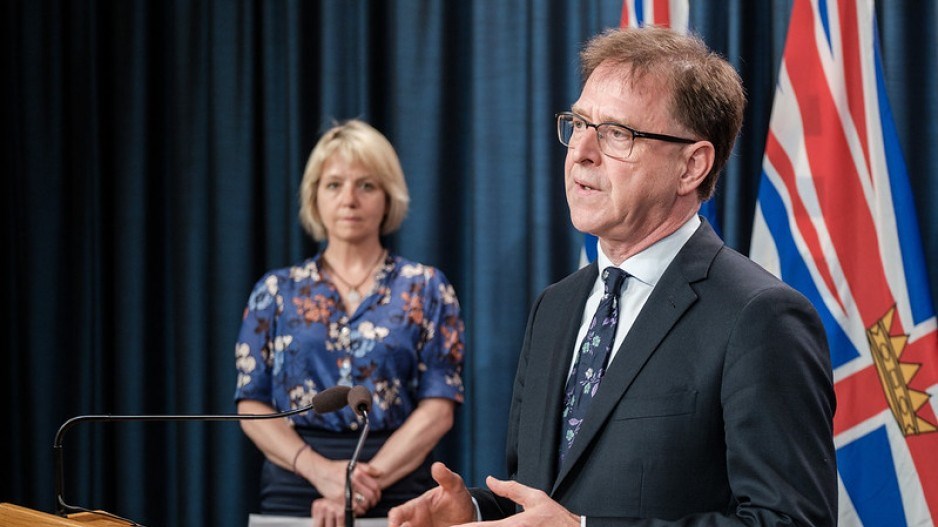By late October, B.C. could be gripped by both a second wave of COVID-19 and seasonal influenza – something that could strain the health care system.
Fortunately, B.C. is in a much better position to manage potential surges in hospitalizations than it was in the spring.
It has more available hospital beds, ventilators, N95 masks, COVID-19 testing capacity, and better contact tracing.
And it may be that this year’s flu season is comparatively mild, thanks to a society that has become accustomed to social distancing, frequent hand-washing, and the wearing of masks. It is also hoped that citizens will take advantage of increased flu vaccine availability.
But the province is still preparing for a worst-case scenario, which would be a major second wave of COVID-19 converging with a bad flu season.
"We're preparing for the challenges that the influenza season will bring to an already challenging pandemic situation," said Premier John Horgan at a press conference Wednesday.
B.C. Health Minister Adrian Dix and provincial health officer Bonnie Henry on Wednesday outlined the province’s fall pandemic plan, which is based on four scenarios, from best to worst-case.
The plan includes additional funding for health care -- $1.6 billion in total – and thousands more front-line health care workers. It includes:
increased testing for COVID-19
increased contact tracing
enhanced influenza immunizations
up to 5,000 new hires for cleaners, food servers and aids for hospitals
2,000 additional workers for long term care and assisted living
a new Hospital At Home program
The province is earmarking $42 million for the Hospital At Home program, a new program which will offer 24-7 medical care for eligible patients. By treating them in their homes, the risk of them spreading flu or COVID-19 to others in hospital is reduced.
The government is allocating $44 million for the recruitment and training of 7,000 new health care workers, through the new Health Career Access Program.
Hospitalizations due to influenza typically begin to rise in September and peak in December and into January. In the past, hospitalizations for respiratory illnesses have been as high as 126 during the peak of flu season in December and January.
The fear is that, in a worst-case scenario, large numbers of people could become ill with either influenza or COVID-19, or both. A worst-case scenario would be 400 patients in hospital and 219 in intensive care.
"The B.C. health system is well-placed to meet the demand with the backstop of knowing that we can successfully implement more extreme hospital access control measures, if they are required," Dix said.
In March, to prepare for a worst-case scenario, the province cancelled all elective surgeries, and designated some hospitals for COVID-19 patients. B.C. health officials do not plan to resort to a blanket, system-wide cancellation of surgeries and other hospital services this fall.
Rather, it would be more targeted according to regions experiencing the worst surges. It is expected that the Lower Mainland would experience the worst surge.
Health officials also plan to maintain current visitations for residents of long-term care homes.
Health officials are crossing fingers that the flu season will be comparatively mild, as a result of all the measures that people have become accustomed to: social distancing, limiting social interactions, frequent hand-washing, the wearing of masks and increased immunization.
In terms of equipment, like ventilators and N95 masks, the province is better situated than it was in the spring. For example, the province has stockpiled 6.3 million N95 or equivalent masks.
Flu immunization will not be mandatory. But based on the experiences of Australia and New Zealand, the province expects an increase in voluntary immunization.
"Their immunization rates were very high," Henry said.
Both countries have had relatively mild flu seasons.
The province has ordered 450,000 additional doses of flu vaccine, bringing the total to 2 million.
"Our fall influenza campaign is going to be on a scale we have not yet seen, to further protect people who are vulnerable in this province," Henry said. "We encourage everybody who is over the age of six months to be immunized for influenza."
As for testing for COVID-19, about 5,000 tests per day are now being done, with a capacity to do 8,000 to 10,000 per day. The province will try to double that capacity to 20,000 tests per day by late October.
Since the elderly are most vulnerable, the province will take steps to beef up the immune systems of care home residents and front-line staff.
The province has purchased 45,000 doses of Fluzone High-Dose vaccines, which contains higher levels of antigens. It is typically given to the elderly to increase their immunity even more than regular flu vaccines. An additional 2,000 workers will be hired for long-term care homes.
Asked about sick pay for people who develop flu or COVID-19 symptoms and need to stay home from work, Horgan said a national sick pay program is being launched this fall.
While British Columbians are being asked to once again start limiting their social interactions, it may that some of the extraordinary measures that were put in place in March will not have to be repeated.
For example, Henry said one of the questions she gets asked by children is whether they can still go trick-or-treating at the end of October.
"Yes, absolutely I think we can have Halloween this year," she said. "It's just going to look different, just like everything looks different during this pandemic."



